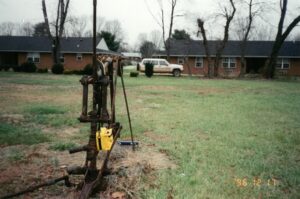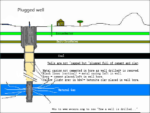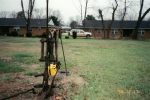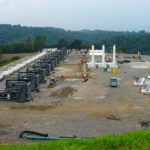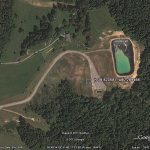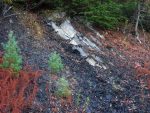Important Information about Oil and Gas Well Plugging.
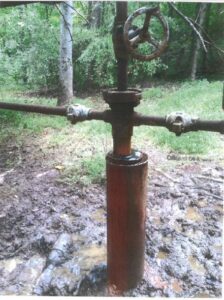 WVSORO has three purposes for creating this web page and this well plugging slide show (you can go to the first slide of the slide show or to the slideshow index). But first some background.
WVSORO has three purposes for creating this web page and this well plugging slide show (you can go to the first slide of the slide show or to the slideshow index). But first some background.
Concentric layers of protective metal pipe casing (some of which is cemented into the well bore) are placed in oil and gas wells as the wells are drilled down into the ground. Decades later, when the wells are no longer producing oil or gas and are considered “abandoned”, the casing pipe will eventually go bad, and that will often cause problems. The gas can leak up into ground water. Surface pollution can leak down into groundwater. Fluids can leak out onto the ground. The gas can leak up into coal formations, into other gas formations, and into other porous or permeable formations between the producing formation and the surface. Gas can even leak out into the air which is happening with 20% of 112 plugged wells in 13 counties in one study by Princeton and McGill Universities.
And oh yes, if you own the surface where the well is located, then at a very minimum, the existence of the unplugged or poorly plugged well can seriously decrease the value of your land, plus areas of your land will not be usable for anything else. And of course that pollution of your surface, groundwater and air can occur on your land, in your water and stink up your air.
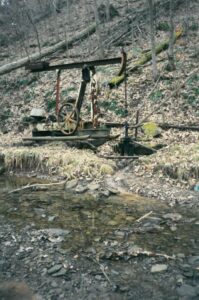 So getting wells plugged and getting wells plugged properly is important.
So getting wells plugged and getting wells plugged properly is important.
View this slide show in order to better understand the oil and gas well plugging process that should occur when an oil or gas well is no longer producing gas in paying quantities (or, in State law, has not produced in the last 12 months (unless it has a State “bona fide future use” approval)).
Note that this slide show is a simplification and overview of the process to illustrate WVSORO’s 3 purposes below. This slide show by no means reflects all of the many activities during the steps illustrated, or in between the steps illustrated – or what may be needed for different wells in different geologic areas. (If you are knowledgeable and see real errors, please let us know.)
WVSORO’s purpose inputting together this slide show is to explain 3 things about oil and gas well plugging.
1: Wells are plugged not “capped”.
A plugged oil or gas well is not like a coke bottle with a cap on top. Wells need plugged down through their entire depth. Capping would be cheap and simple, but would not prevent leaks or seepage from the well that could cause damage to the surface, ground water, air, other formations etc. Plugging is time consuming and complex, and therefore costly to do right.
2: Plugging wells the right way is important.
A survey of some plugged wells by scientists from Princeton and McGill universities found that 20% of a sample of plugged wells in 13 counties in West Virginia were leaking some methane! Another slide show on this website titled “How a Gas Well Is Drilled Down Into the Ground, and What Can Go Wrong” explains how an oil or gas well borehole is drilled, plus how it is lined with several concentric layers of metal casing pipe and with tubing inside that, and how some of that casing pipe is cemented to the inside of the well bore. The casing pipe is to get the gas out while protecting the surface, ground water, other resources etc. That slide show on how a well is drilled illustrates and explains what can happen when something goes wrong during initial drilling and casing: Oil and other liquid contaminants can end up on the surface. Surface pollution (like in cow meadows) can leak down into good groundwater. Septic system problems can leak into good groundwater. Deeper ground water containing iron or sulfur can leak upward into good, clean, potable groundwater used for water wells. Methane gas can leak into the air, it can leak into groundwater (and even come out sink spigots), and it can migrate into coal seams or from one gas formation to another etc. etc.
A bad plugging job can allow all of those same things to occur! For brevity, this slide show does not show precisely how all those problems can be caused by/during a bad plug job, but it is easy to understand from viewing the slide show above that is about drilling, casings and cementing the pathways for that to occur.
Update: The 2025 Legislature relaxed some plugging standards. This is noted at the appropriate slide in the plugging slide show linked above.
3: It is easy and financially tempting for well pluggers to cheat.
Plugging a well from the bottom to the top is costly and time consuming and takes many steps. A plugging company can easily get away with money-saving shortcuts, omissions of steps, negligence, failure to deal with unforeseen problems etc. That is because the work, or the inadequacy of it, is buried deep in the ground and is hidden forever unless someone was there watching the plugging company as it erred. The plugging company’s failures may only come to light later when a problem occurs – and then it may be hard to know for sure if the problem came from a poorly plugged well, or which well it is that was poorly plugged.
A long-ago director of the West Virginia DEP Office of Oil and Gas told the story that his first job as a youth was working for a well-plugging contractor. The plugging contractor finished plugging a first well with cement, and when the inspector came out to check that the job was done, the plugging contractor showed the inspector all the empty cement sacks to prove that the company had used the cement from all the empty sacks to plug that well all the way from the bottom to the top. Then the company moved to a different well. At the second well the contractor just put a little cement in the top of the second hole and waited a while. Then when the inspector came out, the plugging company showed the inspector all the same empty cement sacks from the first well to convince the inspector that he had plugged the second well all the way up and down.
Plugging needs strict oversight by the State plus the notice to opportunity for oversight of the work by surface owners, coal owners and others.
So go to the first slide of this well plugging slide show (or to the slideshow index) to learn about how a well is plugged not capped, to learn the right way for a well to be plugged, and to learn why plugging companies need lots of oversight to prevent well pluggers from yielding to the financial temptation to do an easily hidden bad job.

